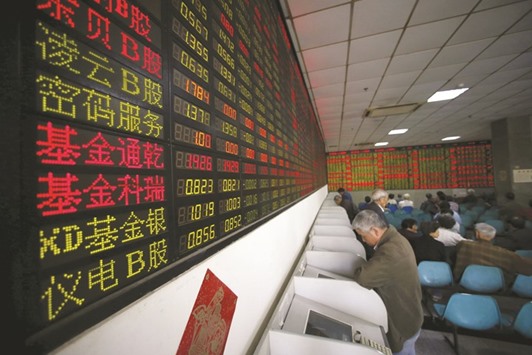China’s grip on the stock market is making life hard for the nation’s traders.
The Shanghai Composite Index has swung less than 1% at the daily close for the past 17 days, a phenomenon that last occurred in 2001 when the nation’s equity market was just a decade old. Turnover is down 76% from last year’s peak and a measure of volatility has dwindled to a two-year low.
While other global equity markets are also experiencing muted trading, the subdued nature of Chinese shares follows extreme intervention by policy makers to stabilise the world’s second-largest stock market in the wake of last year’s $5tn rout.
With state-backed funds holding sizeable stakes in listed companies, any attempt by them to trim holdings can spur a broader sell-off, prompting the funds to step back in again, according to Jingxi Investment Management Co. “It’s becoming difficult for us to play in the market now,” said Wang Zheng, Shanghai-based chief investment officer at Jingxi. “The ‘national team’ is very deeply involved, and its main purpose is to prevent the market from moving up or down too extremely.
Sometimes when the market looks set to break out and you buy shares to wait for them to rise, the good momentum would suddenly stop.”
The moves in the Shanghai Composite Index are a far cry from the start of the year, when the introduction of circuit breakers helped spur daily losses in excess of 6%.
In 2015, volatility rose to an 18-year high as tumbling share prices prompted leveraged investors to unwind bullish bets. The measure added 0.1% at Thursday’s close.
Globally, equity markets are turning more muted as investors wait for more clues on when the Federal Reserve will increase borrowing costs. A gauge of 50-day price swings on the MSCI All-Country World Index has dropped to a two-year low, while the main US equity index has held in a band of 1.5% for 39 days, the narrowest ever for that length of time.
Still, the hand of the Chinese state has been increasingly seen in the nation’s markets, with a drop in foreign-exchange reserves indicating currency intervention, the central bank saying it wants to reduce leverage and regional authorities extending property cooling measures. Government-backed funds were seen selling bank shares in mid-August as the Shanghai Composite rose to a seven-month high, while the Communist Party’s top decision-making body said in July that the nation would curb asset bubbles.
State-backed funds hold an estimated 1.2tn yuan ($180bn) of stocks, about half the size of the nation’s equity-focused mutual funds, according to Howbuy, a Shanghai-based fund tracker.
For Mo Haibo, the best strategy for investors now is to stick to stocks with solid earnings and avoid high-valuation, smaller companies. His Wanjia Selective Mixed Fund has returned 8% this year, compared with a 13% decline on the Shanghai Composite.
“Though the benchmark hasn’t moved much recently, there are some stocks that have performed quite well,” said Mo, head of research and investment at Wanjia Asset Management Co in Shanghai. He said he’s overweight infrastructure-related stocks as the government encourages private investment in projects from water conservancy to environmental protection. He didn’t name any specific stock.
As for Jingxi Investment’s Wang, he said he likes chasing shares tied to short-lived themes, including property and infrastructure shares, and avoids stocks that are held heavily by the state.
For the market to break out of the lacklustre pattern, the government will need to deliver a signal that it is loosening its grip on the market, said Zhang Gang, a strategist at Central China Securities Co in Shanghai.
Until there is “a breakthrough, funds are still on the sidelines,” he said.

Investors look at computer screens showing stock information at a brokerage house in Shanghai. The moves in the Shanghai Composite Index are a far cry from the start of the year, when the introduction of circuit breakers helped spur daily losses in excess of 6%.


